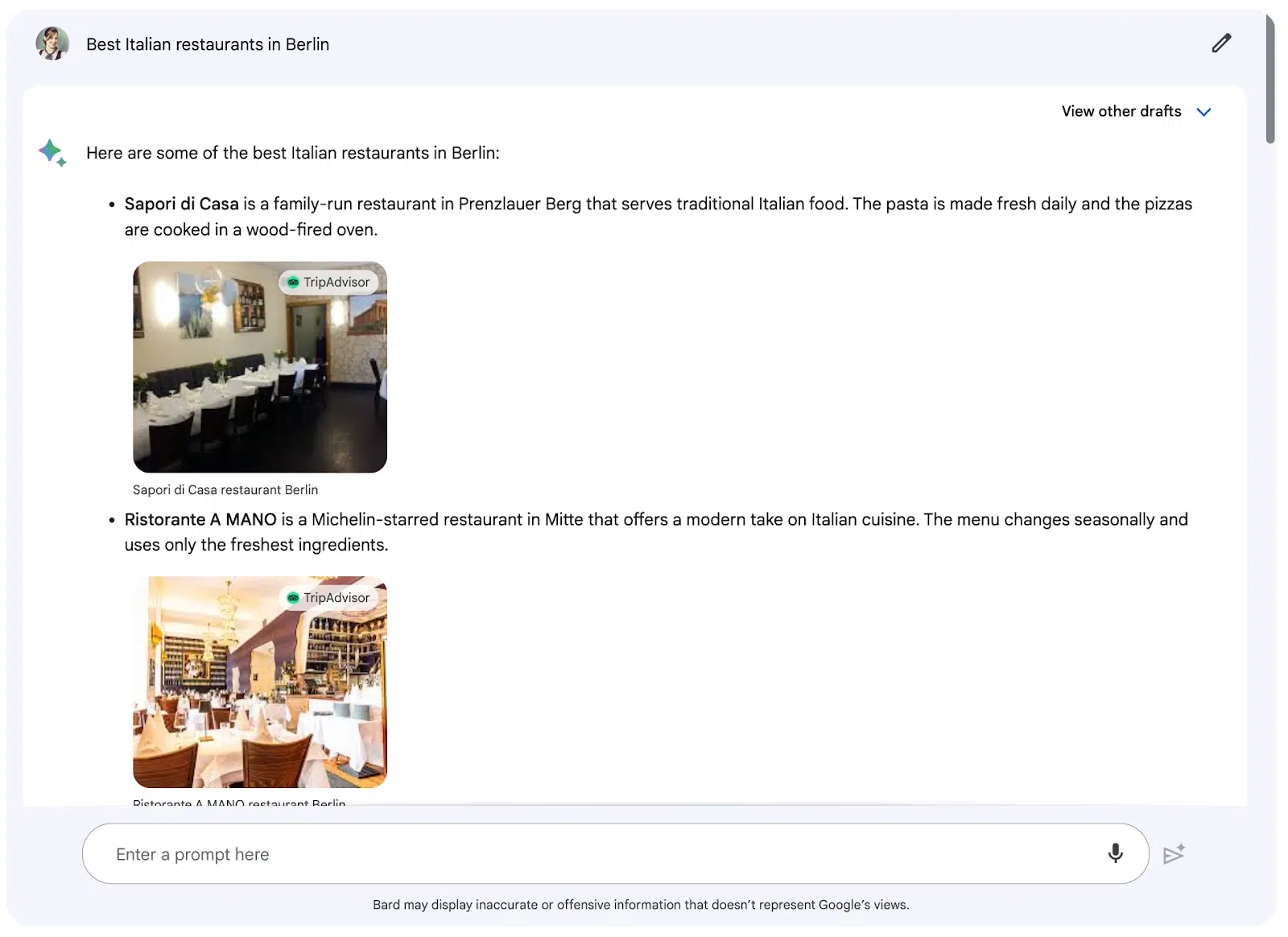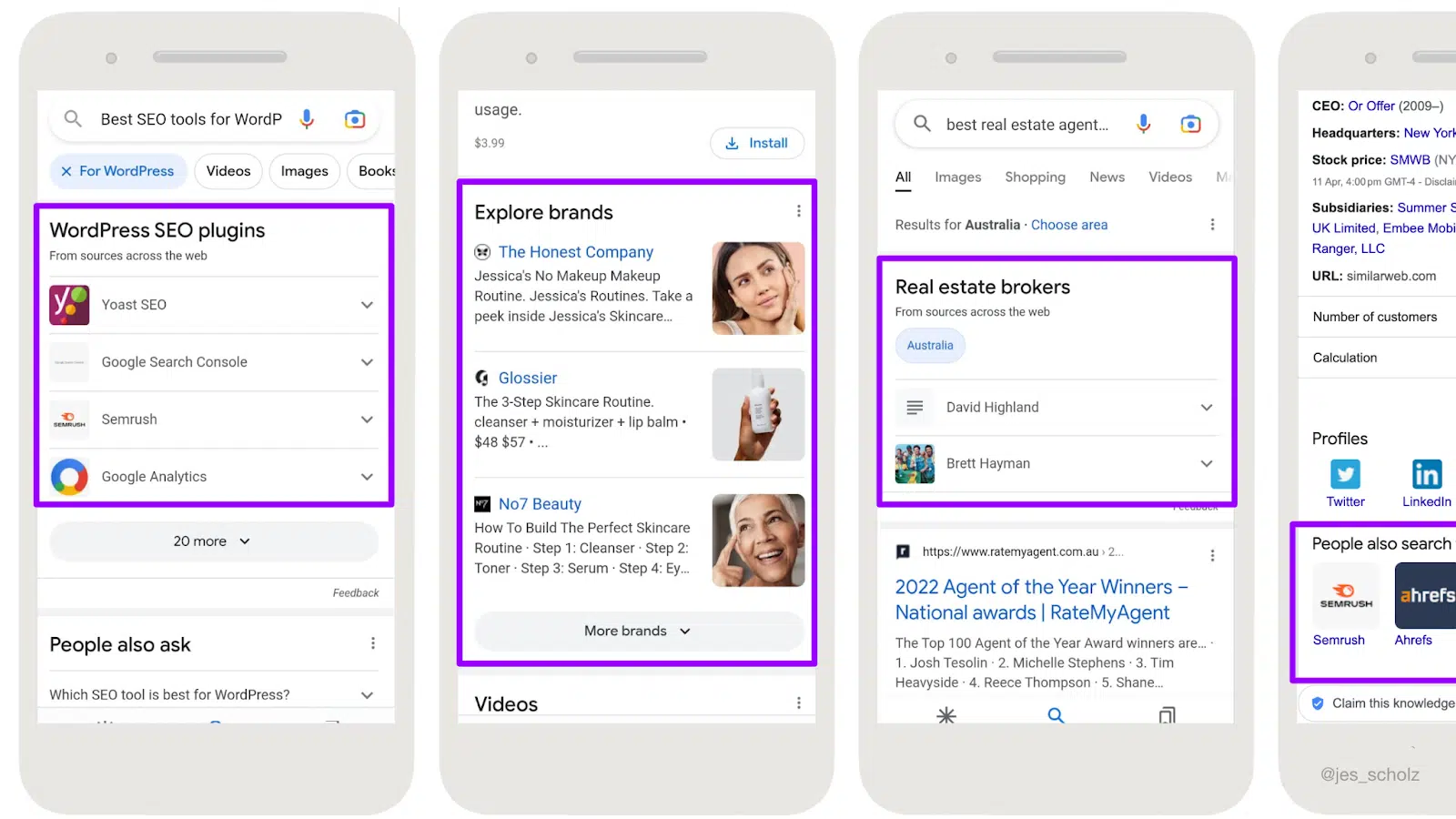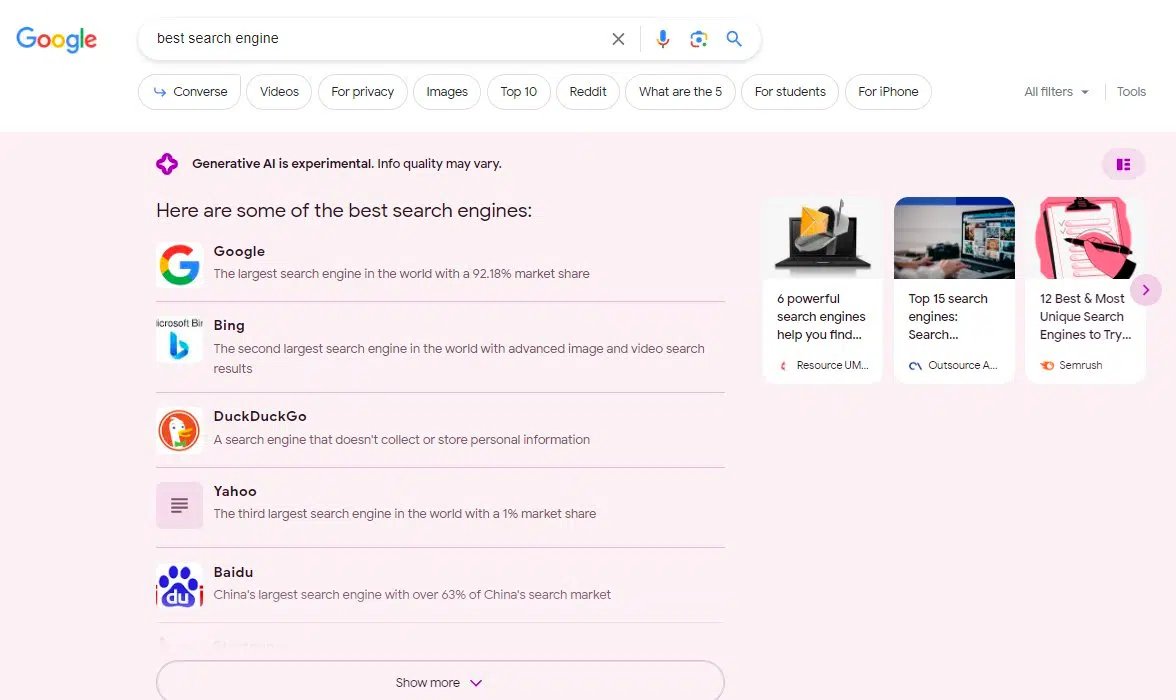How to establish your brand entity for SEO: A 5-step guide
A well-known, top rated and trusted brand entity is the cornerstone of organic visibility. Here's how to build yours in five steps.
Google’s announcement of Search Generative Experience (SGE) and the release of Bard are reshaping the digital landscape. These evolutions have many SEO implications. One of the most important is the renewed focus on brand entity SEO.
In the past, SEO was largely focused on marketing to humans. However, with the rise of large language models, such as OpenAI’s GPT-4 and Google’s PaLM 2, MUM and BERT, SEO is now also about marketing to machines.
But no matter the interface, whether blue links, rich results, Google surfaces, SGE or chatbot, the timeliness imperative of SEO is for searchers to find and choose our brand.
And no matter the user, whether human or AI, brand awareness and brand preference are vital for inclusion in the target audience’s consideration set.
Therefore, building a well-known, top rated and trusted brand entity is the cornerstone of organic visibility.
Brands, entities and the Google Knowledge Graph
The Google Knowledge Graph is a database that understands relationships between and “facts” about entities.
Google defines an entity as “a thing or concept that is singular, unique, well-defined and distinguishable” that is represented linguistically by nouns. For example, an entity may be a person, place, product, event, idea or brand.
Knowledge Graphs allow entities to be contextualized through their connections to other entities.
So when I type into Bard “Best Italian restaurant in Berlin,” it does not match based on keywords, but rather on entities.

It connects the:
- Location entities: Neighborhoods of the city of Berlin (Prenzlauer Berg, Mitte, etc.)
- Cuisine entity: Italian
- Dish entities: Pasta, pizza
- Restaurant brand entities: Sapori di CasaIl Punto, Ristorante A MANO
- Directory brand entities: TripAdvisor, Top10 Berlin
And the “facts” it knows about the restaurant entities in terms of reviews to present its opinionated recommendations.
A similar process happens in the SERPs to create rich results such as local packs or related searches.

There are many Knowledge Graph entities you could optimize for, including:
- Location: City and neighborhood
- Cuisine: Italian
- Dishes: Pizza, pasta, etc
- Ambiance: Fine dining, family-friendly, etc
- Awards: Michelin stars, Gault et Millau, etc
- People: Owner, Chef, etc
But the most valuable is the brand entity. This must be at the center of all things.
Brand entity SEO already significantly impacts most industries where we see many entity-only rich results in the SERPs.

And it will impact every industry as Bard becomes more popular and SGE rolls out.
Why? Because Google is disinclined to give visibility to brands it doesn’t know explicitly.
If your brand is not an entity in the Knowledge Graph, Google has less confidence in the ‘facts’ about that brand, its relevance to the user query and its relationship to other entities.
In this case, Google will only partially apply entity-level visibility signals (formerly known as site-level ranking factors, but rank is somewhat antiquated and a brand entity is more than just a website).
This means your brand is significantly less likely to be included in the AI’s consideration set. And since Google’s AI acts as a gatekeeper, also the end user’s consideration set.
If, on the other hand, Google has a detailed dossier for your brand entity and its relationships to other entities in the Knowledge Graph, it can confidently make matches that matter. Granting you more visibility in the SERPs, Bard, Discover and other Google surfaces.
To build your brand into an entity, follow these five steps.
Step 1: Secure CMO sponsorship
Building a brand entity is not a solo mission.
It goes beyond the scope of what SEO has commonly been defined to encompass. This is branding, this is your CMO’s territory. You will struggle to make meaningful changes if you do not have them onboard.
Get in front of your CMO and convince them to be the executive sponsor of a ‘brand entity establishment’ project.
This not only secures their buy-in for the idea but also their guidance and ability to free up resources in other departments, such as development or content resources, that will be needed.
To get a CMO onboard, show the opportunity (or threat depending on their mentality) through presenting:
- Your branded SERP: Do you dominate it with a fully-fleshed out knowledge panel, social media profiles and digital PR articles or at there irrelevant or unwanted links.
- Industry-relevant entity-only SERP features: What rich results exist for key user intents and is your brand included (being on mobile and incognito is essential).
- Industry-relevant Bard results (and SGE if you have access): What results are returned for key user intents and is your brand included.
- Current brand entity presence: What does Google understand about your brand entity its associated assets and its connections to other entities.
- Competitor brand entity presence: What does Google understand about your competitors’ entities.
When assessing brand entity presence, don’t be fooled into thinking this has anything to do with the number of branded search queries or number of indexed pages of a website.
To understand if a brand is an entity, and if so, in what context, the ideal is to query the brand name in the Google Knowledge Graph Search API daily and keep a record of the returned result details.
But for a quick check, it’s easier to use the Kalicube Google Knowledge Graph API Explorer.
Step 2: Define and align your brand entity bio
To become an entity in the Google Knowledge Graph, you must be clear and consistent on who your brand entity is and your relationship to other entities.
Start by defining your official brand name.
I know this sounds ridiculously easy, but I have a challenge for you. When you are next in your office, ask someone from each department to write down the brand name on a piece of paper.
Some will write:
- The brand you expect: “Brand Name”
- The brand with different spacing: “BrandName”
- The brand with different capitalization: “Brandname” or “brandname”
- The partial URL: “brandname.com”
- The legal entity: “Brand Name Inc.”
As Google’s natural language processing is sensitive to spelling and casing, these can all be interpreted as different entities.
Once you settle on an official brand name, define a brand entity bio. The aim is to tell Google about your brand in a way its algorithms can confidently understand in order to extract “facts” and connections.
The entity bio should begin with a semantic triple to summarize the brand entity in a way Google can clearly understand.
For example:
- “Jes Scholz is a marketing consultant.”
Where “Jes Scholz” is the entity subject, “is” is the predicate, and “marketing consultant” is the object.
That said, a pure semantic triple can be a bit too bland for the humans that will read the bio. So feel free to spice it up with an adjective or a secondary object.
For example:
- “Jes Scholz is an organic marketing consultant and SEO futurist.”
Where “organic” is the adjective and “SEO futurist” is the secondary object.
Then address your core offering and target audience. For example:
- “She delivers award-winning audience development strategies focused on entity optimization, smart content distribution and data-driven marketing from Sydney to enterprise businesses worldwide.”
Then expand on this with concise paragraphs that address all key details about your brand entity in order of importance for your market. For example, the:
- Core value propositions
- Awards
- Key people or partners
- Relevant history
This should all be written with a view to building Google’s understanding of your brand entity and what other entities, especially topical entities, you are related to.
As Google’s confidence in these areas grows, so do your chances of appearing on Google surfaces.
Once you have drafted your brand entity bio, evaluate it with Google’s Natural Language API (you can use the free demo) to see how Google processes the text, identifies entities within it and categorizes it.
To go into more detail, I strongly recommend you read the full works of Jason Barnard and his Kalicube process.
Once you have defined a clear, meaningful and topical brand entity bio and aligned it with all key stakeholders, it’s time to repeat it ad nauseam. Brandsplain it through corroboration.
Step 3: Corroborate topical relatedness
Google understands entities based on relatedness, which is determined based on the co-occurrence of entities.
If two entities, like a brand and a topic, are referenced together frequently by multiple authoritative sources, it strengthens Google’s connection of those two entities in the knowledge graph.
This has many benefits but is especially powerful when it comes to generative AI marketing.
I was amused by a recent SGE example tweet from Lily Ray. But similar associations of a brand, in this case, “Google”, and a topic, in this case, “search engines”, can apply to any industry.

If your brand doesn’t have an industry association, you won’t show in the list when searchers ask for the thing your brand does. Establishing entity co-occurrence through authoritative repetition is key.
As your site should be the most authoritative source on your brand entity. Your About page, as your “entity home,” is the first place to publish your brand entity bio.
The About page is better than the homepage as it can be dedicated primarily to the brand entity.
At the same time, the homepage must represent the entire website offering and potentially other entities as well, such as products, clients or key members of the team.
That said, aspects of the brand entity bio should be seen in the homepage copy. It is a point of corroboration.
This will be true of many of your brand assets that will duplicate appropriate aspects of the brand entity bio, especially the semantic triple about what the brand entity is. This should feature in:
- All social media profiles, such as LinkedIn, Twitter or TikTok.
- Relevant business directories, such as CrunchBase, Trustpilot or Yelp.
- Relevant industry sites, such as Entrepreneur.com, Forbes or Spotify.
- A Google Business Profile for any brand with a physical address.
- If possible, Wikipedia and Wikidata.
During this process, don’t neglect to revisit previously posted digital PR articles. Fact-correct them and request changes as needed to ensure the details align with your official brand name and bio.
This repetition on relevant platforms is vital. The more corroboration, the greater Google’s confidence their “knowledge” about your brand entity is credible and the more notable they believe your entity is. Both of these increase the likelihood that Google will show your brand entity for a topical query.
But don’t spam! If a site is authoritative but not appropriate to your industry, it won’t help. If a site is industry-appropriate but low quality, it won’t help. If the social profile is inactive, it won’t help.
Step 4: Markup all the things
Using Organization schema markup in JSON-LD format on the About page.
Think of it as communicating to the search engine’s in their mother tongue. Allowing you to confirm important attributes of the brand entity is a critical step to Google accepting those “facts.”

Google’s Logo (Organization) Structured Data only requires:
- URL: The homepage URL of the brand website
- Logo: The logo of the brand
Don’t implement this blindly.
When relevant, use a more descriptive “@Type”. Organization is the most general. There are potentially more relevant subtype values.
A newspaper can identify as a NewsMediaOrganization. A charity can identify itself as an NGO. Local businesses can choose from many descriptive categories such as Florist, Restaurant or RealEstateAgent.
Also, go beyond the required properties. Include as much relevant information as the structured data allows, to establish ‘facts’ about your entity in the Google Knowledge Graph.
Pay special attention to:
- Name: The official brand name you have aligned with stakeholders.
- AlternateName (if needed): An shorter variation of your official brand name that is commonly used on the wider web for your brand entity. For example, the Better Business Bureau being called the BBB.
- LegalName: Add the legal entity name to help disambiguate references on the wider web of your brand entity.
- Description: The semantic triple from your entity bio.
- Image: An array of ImageObjects which represent the brand.
- Address, telephone and email: Brands with readily available contact details are inherently more trustworthy.
- Awards: Being nominated for or winning awards boosts credibility.
- @id: An identifying URL intended as the explicit, unambiguous reference for your company. As such it should be unique and never change. Jono Alderson, Head of SEO at Yoast, recommends site’s home URL appended by #/schema/Organization/1.
- SameAs: To disambiguate your brand entity presence to aid corroborations, list all relevant brand profiles. Include active social media pages, directory listings, wikipedia and wikidata entries and Google Business Profile and Google knowledge panel URL (aka https://www.google.com/search?kgmid={id}) when available. If your brand has multiple knowledge panel URLs, add them all to help consolidate them into a single strong entity.
Once the about page contains a valid structure data markup brand bio, manually submit the URL in Google Search Console to encourage Googlebot to swiftly update the details in its index.
But don’t stop your entity optimization there.
Step 5: Establish related entities
Every relevant entity on your site should be marked up with structured data.
When these entities are explicitly understood by search engines, it strengthens the connection between those recognized entities and the brand entity.

This can work to strengthen the brand’s notability further. Relatedness increase the probability of your brand being found in the context of topical queries.
While this article focuses on brand entity optimization, you can adjust the process to establish other business assets.
Your key people, podcast, products or events can all become entities in the knowledge graph. Which is beneficial in its own right as those entities can earn visibility in the Google ecosystem.
But additionally, building Google’s confidence in its understanding of these other entities can further cement Google’s understanding of the brand entity due to the connection between the assets.
This entity relationship building can also work beyond the bounds of your owned assets.
Collaborating with established high-authority entities related to your industry or a targeted topic can solidify your own status within that area.
Andrea Volpini’s work on semantic SEO is, in my opinion, foundational in this area and is well worth a read.
Building a strong brand entity
If you want to be visible in generative AI, build a strong brand entity in the knowledge graph.
This allows you to control the brand positioning Google presents to your audience while increasing the chance your brand will be shown on Google surfaces.
The importance of entities is only going to grow. Now is the time to invest.
Contributing authors are invited to create content for Search Engine Land and are chosen for their expertise and contribution to the search community. Our contributors work under the oversight of the editorial staff and contributions are checked for quality and relevance to our readers. The opinions they express are their own.
Related stories